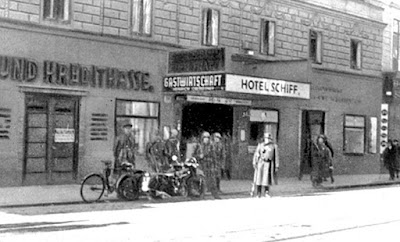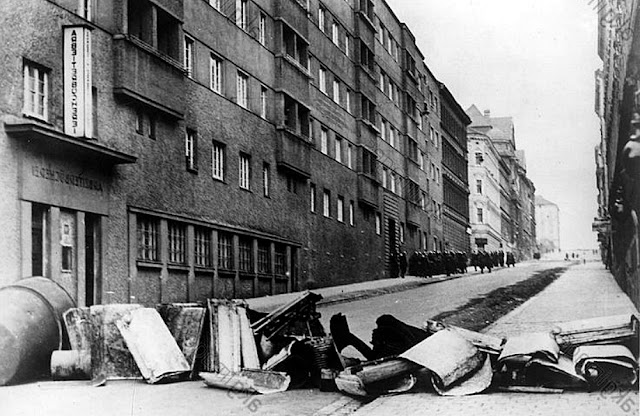Wednesday, April 5, 2023
The Austrian Civil War
The Austrian Civil War, also known as the February Uprising, is a term sometimes used for a few days of skirmishes between socialist and conservative-fascist forces between 12 February and 16 February 1934, in Austria.
After First World War, Austria became constituted as a parliamentary democracy. Two major factions dominated politics in the new nation: socialists (represented politically by the Social Democratic Workers' Party) and conservatives (politically
represented by the Christian Social Party). The socialists found their strongholds in the working class districts of the cities, while the conservatives could build on the support of the rural population and of most of the upper classes.
Both the socialist and the conservative camp possessed their own paramilitary forces. The conservatives began organising the Heimwehr (or Homeguard) in 1921. In response, the Social Democrats organised paramilitaries called the Republikanischer Schutzbund (or Republican Protection Association) after 1923. Altercations and clashes between these forces occurred frequently.
On 4 March 1933, Christian Social Chancellor Engelbert Dolfuss suspended the Austrian Parliament. The Social Democratic Party had thus lost its major platform for political action. The conservatives, facing pressure and violence not only from the left but also from Nazis infiltrating from Germany, could now rule by decree on the basis of a 1917 emergency law, without checks on their power, and began to suspend civil liberties. They banned the Schutzbund and imprisoned many of its members.
On 12 February 1934, a force, led by Heimwehr commander in Vienna, Emil Fey, searched Hotel Schiff in Linz, a property belonging to the Social Democratic Party. Linz Schutzbund commander Richard Bernaschek was the first to actively resist, sparking off armed conflict between a conglomeration of the
Heimwehr, the police, the gendarmerie and the regular Federal Army against the outlawed, but still existent, socialist Schutzbund. Skirmishes between the two camps spread to other cities and towns in Austria, with the heat
of the action occurring in Vienna. There, members of the Schutzbund barricaded themselves in city council housing estates (Gemeindebauten), the symbols and strongholds for the socialist movement in Austria, such as Karl-Marx-Hof.
Police and paramilitaries took up positions outside these fortified complexes and the parties exchanged fire, initially only with small arms. Fighting also occurred in industrial towns such as Steyr, Sankt Pölten, Weiz, Eggenberg, Kapfenberg, Bruck an der Mur, Graz, Ebensee and Wörgl.
An apparently decisive moment in the events came with the entry of the Austrian armed forces into the conflict. Though the army remained still a comparatively independent institution, chancellor Dollfuss ordered Karl-Marx-Hof shelled with light artillery, endangering the lives of thousands of civilians and destroying many flats before forcing the socialist fighters to surrender. Viennese and Upper Austrian fighting ended by 13 February, but continued heavily in Styrian cities, especially in Bruck an der Mur and Judenburg, until 14 or 15 February. After that, there were only small groups of socialists fighting against the armed forces, or fleeing from it. By 16 February 1934, the Austrian Civil War had ended.
Several hundred people (including paramilitaries, members of the security forces and civilians) died in the armed conflict; more than a thousand suffered wounds. The authorities tried and executed nine Schutzbund leaders under the provisions of martial law. In addition, over 1,500 arrests were made. Leading socialist politicians, such as Otto Bauer, were forced into exile.
Though small in scale, the Austrian Civil War nevertheless proved a decisive moment in the history of the Austrian Republic. The incidents of February 1934 were taken as a pretext by the government to prohibit the Social Democratic Party and its affiliated trade unions altogether.
In May, the conservatives replaced the democratic constitution by a corporatist constitution modelled along the lines of Benito Mussolini's fascist Italy; therefore the socialists coined the term 'Austrofascism' although the underlying ideology was essentially that of the most conservative elements in the Austrian Catholic clergy, a feature inconsistent with both Italian Fascism and Nazism. The Patriotic Front, into which the Heimwehr and the Christian Social Party were merged, became the only legal political party in the resulting authoritarian regime, the Ständestaat. Chancellor Engelbert Dollfuss was assassinated as part of a failed coup attempt by Nazi agents on 25 July 1934.











